
Bhima, also known as Bhimasena, is a hero and one of the most prominent figures in the Hindu epic Mahabharata, renowned for his incredible strength, fierce loyalty, and key role in the epic's narrative. As the second of the five Pandava brothers, Bhima was born to Kunti—the wife of King Pandu—through the blessings of Vayu, the wind god, which bestowed upon him superhuman strength from birth. His rivalry with the Kauravas, especially Duryodhana, defined much of his life, with this tension ultimately erupting in the Kurukshetra War, where Bhima killed all hundred Kaurava brothers.

Duryodhana, also known as Suyodhana, is the primary antagonist in the Hindu epic Mahabharata. He was the eldest of the Kauravas, the hundred sons of the king Dhritarashtra and his queen Gandhari.

Sahadeva was the youngest of the five Pandava brothers in the ancient Indian epic, the Mahabharata. He and his twin brother Nakula were the sons of Madri, one of the wives of the Pandava patriarch Pandu, and Ashvini Kumaras, the divine twin physicians of the gods, whom she invoked to beget her sons due to Pandu's inability to progenate. Kunti, Sahadeva's step-mother, loved him the most despite his birth to Madri. Sahadeva is renowned for his wisdom, knowledge of astrology, and skill in swordsmanship.

The Kurukshetra War, also called the Mahabharata War, is a war described in the Hindu epic poem Mahabharata, arising from a dynastic struggle between two groups of cousins, the Kauravas and the Pandavas, for the throne of Hastinapura. The war is used as the context for the dialogues of the Bhagavad Gita.

Kosala is the kingdom of Rama mentioned in the Ramayana. Ayodhya was its capital and is now located in Uttar Pradesh. Rama's sons Lava and Kusha inherited parts of this kingdom. Lava ruled from the city called Shravasti, and Kusa from the city called Kushavati. A colony of Kosala kings existed in Madhya Pradesh. It was called Dakshina Kosala. Rama's mother Kausalya was from this kingdom. Rama extended his influence up to the island-kingdom of Lanka situated in the Indian Ocean. He had friendly relations with the southern kingdom of Kishkindha.

The Dasarna kingdom was one of the many kingdoms ruled by Yadava kings in ancient central and western India. It lay to the south of the Chedi and Panchala kingdoms, in northern Madhya Pradesh. The Panchala prince Sikhandi married a princess from Dasarna. Sikhandi was alleged to be 'one of the neuter-gender'. This led to a dispute between the Dasarna king and the Panchala king Drupada.
The historical Avanti kingdom of ancient India is described in the Mahabharata epic. Avanti was divided into north and south by river Vetravati. Initially, Mahissati was the capital of southern Avanti, and Ujjaini was of northern Avanti, but at the times of Mahavira and Buddha, Ujjaini was the capital of integrated Avanti. The country of Avanti roughly corresponded to modern Malwa, Nimar and adjoining parts of the Madhya Pradesh.
Madra kingdom was a kingdom grouped among the western kingdoms in the ancient Indian epic Mahabharata. Its capital was Sagala in the Madra region. The Kuru king Pandu's (Pāṇḍu) second wife was from Madra kingdom and was called Madri. The Pandava twins, Nakula and Sahadeva, were her sons. Madri's brother Shalya was the king of Madra. Though affectionate to the Pandavas, he was tricked to give support to Duryodhana and fought against the Pandavas during the Kurukshetra War. He was killed by Yudhishthira, the eldest Pandava. Other than the Madra kingdom with Sagala as its capital, it is believed that there was a Western Madra and a Northern Madra.

Gandhāra was an ancient Indian kingdom mentioned in the Indian epics Mahabharata and Ramayana. Gandhara prince Shakuni was the root of all the conspiracies of Duryodhana against the Pandavas, which finally resulted in the Kurukshetra War. Shakuni's sister was the wife of the Kuru king Dhritarashtra and was known as Gandhari after the area of Gandhāra. Puskalavati, Takshasila (Taxila) and Purushapura (Peshawar) were cities in this Gandhara kingdom. Takshasila was founded by Rama's brother Bharata. Bharata's descendants ruled this kingdom afterwards. During the epic's period, the kingdom was ruled by Shakuni's father Suvala, Shakuni and Shakuni's son. Arjuna defeated Shakuni's son during his post-war military campaign for Yudhishthira's Aswamedha Yajna.
The Pahlava kingdom is identified to be a kingdom of an Iranian tribe. The kingdom was well known, even during the campaign of Alexander. It was also mentioned in the epic Mahabharata.
Khasas were a north western tribe mentioned in the epic Mahabharata.

Suhma kingdom was an ancient kingdom during the Late Vedic period on the eastern part of the Indian subcontinent, which originated in the region of Bengal. The kingdom included present day districts of undivided Midnapore and parts of Hoogly and Howrah of West Bengal. This kingdom was mentioned in the epic Mahabharata along with its neighbouring kingdom Prasuhma.

Vaṅga was an ancient kingdom and geopolitical division within the Ganges delta in the Indian subcontinent. The kingdom is one of the namesakes of the Bengal region. It was located in eastern and southern Bengal. Vanga features prominently in the epics and tales of ancient India as well as in the history of Sri Lanka.

The Āndhras were an ancient non-Aryan tribe of south-central Indian subcontinent, whose existence is attested during the Iron Age. Andhras were mentioned in the ancient Hindu scriptures such as the Aitareya Brahmana, Ramayana, Mahabharata and Puranas.The Eastern Deccan region originally inhabited by Andhras was called Andhradesa. The modern Indian state of Andhra Pradesh, derives its name from this historic tribe and region.
Nishada is a tribe mentioned in ancient Indian literature. The ancient texts mention several kingdoms ruled by this tribe.
An akshauhini is described in the Mahabharata as a battle formation consisting of 21,870 chariots ; 21,870 elephants ; 65,610 horses and 109,350 infantry. Thus one akshauhini consisted of 218,700 warriors. The ratio is 1 chariot: 1 elephant: 3 cavalry: 5 infantry soldiers. In each of these large number groups, the digits add up to 18.

The Drona Parva, or the Book of Drona, is the seventh of eighteen books of the Indian epic Mahabharata. Drona Parva traditionally has 8 parts and 204 chapters. The critical edition of Drona Parva has 8 parts and 173 chapters.

Suryaputra Karn is an Indian historical epic television series, which premiered on 29 June 2015 on Sony TV. Produced by Siddharth Kumar Tewary of Swastik Pictures, the series covers the life journey of Karna in the Mahabharata. The show starred Gautam Rode, Vishesh Bansal and Basant Bhatt as the lead character at various stages of his life.

The Brihadratha dynasty was the first dynasty of the Magadha Empire, according to the Puranas, and was founded by Brihadratha.










